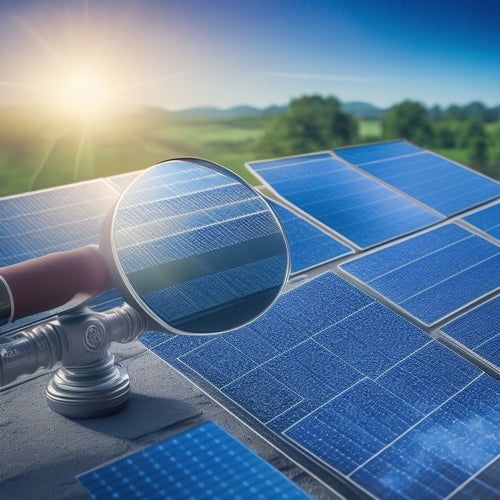
Why Energy Yields Fall Short of Expectations
Share
You expect your solar panel system to generate a certain amount of energy, but it falls short. Why? Unrealistic performance expectations, inaccurate system sizing, and poor panel angle and orientation are just a few factors contributing to underperformance. Inefficient inverter performance, suboptimal energy harvesting strategies, and neglecting scheduled servicing also take a toll. Additionally, environmental factors like soil contamination and tree shading can reduce energy yields. These factors can lead to a 10-20% underperformance, according to the National Renewable Energy Laboratory. Now, let's dig into the specifics to uncover the root causes and potential solutions.
Key Takeaways
• Unrealistic performance expectations and inaccurate sales pitches can lead to energy yields falling short of expectations.
• Inaccurate system sizing calculations, such as oversizing, can result in reduced energy yields.
• Poor panel angle and orientation can significantly reduce energy yields, making obstruction analysis crucial.
• Inefficient inverter performance and neglected maintenance can drain energy yields and cause system downtime.
• Environmental factors, such as soil contamination, atmospheric disturbances, and tree shading, can also contribute to reduced energy yields.
Unrealistic Performance Expectations
When you invest in renewable energy, you likely anticipate significant returns, but often, these expectations are inflated, leading to disappointing outcomes. Overpromising sales and unrealistic benchmarks set by manufacturers or installers can be major contributors to this discrepancy.
You may be promised extraordinary energy yields, but the reality often falls short. This mismatch between expectations and reality can be attributed to various factors, including inaccurate sales pitches, inadequate system design, and insufficient maintenance.
As a result, your returns may not meet your initial projections, leading to frustration and disillusionment. It's crucial to separate fact from fiction and understand the actual potential of your renewable energy system.
Be wary of overly optimistic sales pitches, and instead, focus on data-driven projections and realistic benchmarks. By doing so, you can make informed decisions and set achievable expectations, ultimately avoiding disappointment and ensuring a successful shift to renewable energy.
Inaccurate System Sizing Calculations
When you're designing a solar panel system, you guarantee it'll meet your energy needs, but inaccurate system sizing calculations can lead to oversizing, which wastes resources and increases costs.
You might assume that bigger is better, but oversized systems rarely live up to their promise, and incomplete data analysis only exacerbates the problem.
Oversized System Assumptions
Inaccurate system sizing calculations often stem from oversized system assumptions, which can lead to disappointing energy yields that fall short of expectations.
When you design an energy system, it's important to take into account the complexities of the system and potential design flaws. Oversized systems can be a significant issue, as they can lead to reduced efficiency and decreased energy yields.
You might assume that a larger system will produce more energy, but this isn't always the case. In reality, oversized systems can lead to reduced performance, increased maintenance costs, and decreased system lifespan.
To avoid oversized system assumptions, it's vital to conduct thorough system analysis and design. You should take into account factors such as energy demand, system losses, and environmental conditions. By doing so, you can make sure that your system is correctly sized and optimized for maximum energy yields.
Incomplete Data Analysis
Inaccurate system sizing calculations can also result from incomplete data analysis, which often stems from a lack of understanding of the system's complexities and the failure to take into account all relevant factors.
As you analyze data, you may overlook important details, leading to inaccurate system sizing calculations. This oversight can be attributed to data gaps, which occur when there's a lack of information or inconsistent data collection methods. These gaps can lead to statistical biases, causing your calculations to be skewed.
To avoid this, you must make sure that your data is thorough and reliable. You should also be aware of potential biases in your data collection methods and take steps to mitigate them. By doing so, you can increase the accuracy of your system sizing calculations, ultimately leading to more efficient energy yields.
Poor Panel Angle and Orientation
Your solar panels' suboptimal angle and orientation can reduce energy yields by up to 15%, a considerable loss that can be avoided with proper installation.
When it comes to maximizing energy production, every degree counts. A misaligned panel can greatly diminish energy output, and it's not uncommon for installers to compromise on angle and orientation due to roof constraints.
For instance, a south-facing roof with a 30-degree angle is ideal, but what if your roof has obstructions or an unusual shape? That's where obstruction analysis comes in. By conducting a thorough analysis, you can identify potential obstructions and optimize your panel placement accordingly.
Inefficient Inverter Performance Metrics
Approximately 5-10% of solar panel systems underperform due to inefficient inverter performance metrics, which can silently drain your energy yields without you even realizing it. You might be wondering how this happens.
The truth is, inverters are complex devices that require precise calibration to optimize energy production. If your inverter isn't properly calibrated, it can lead to significant energy losses.
To make sure your system is running at its best, it's essential to implement performance benchmarking. This involves setting clear performance targets and regularly monitoring your inverter's performance against those targets. By doing so, you can identify any deviations from peak performance and take corrective action.
Regular inverter calibration is also necessary to maintain peak performance. By staying on top of inverter performance metrics, you can prevent energy losses and maximize your energy yields.
Don't let inefficient inverter performance hold you back – take control of your energy production today!
Suboptimal Energy Harvesting Strategies
Misaligned energy harvesting strategies can silently sabotage up to 15% of your solar panel system's potential, leaving you with unmet energy expectations. As you invest in renewable energy, optimizing your harvesting approach to maximize yields becomes crucial.
One common pitfall is failing to prioritize energy storage. Without a well-designed energy storage system, excess energy generated during the day is wasted, reducing your overall energy yields. Additionally, this wasted energy could have been stored for later use, enhancing grid resilience during peak hours or power outages.
By integrating energy storage solutions, you can ensure that your system operates at peak efficiency, reducing energy losses and increasing your overall energy independence. By adopting a data-driven approach to energy harvesting, you can identify areas of improvement and make informed decisions to optimize your system's performance.
Insufficient Maintenance and Monitoring
When you're depending on energy systems, you need to stay on top of maintenance and monitoring to guarantee peak performance.
However, you might be falling short in this area, and it's costing you in energy yields.
Lack of Regular Checks
Your solar panels are likely to underperform if you neglect to conduct regular inspections, leading to energy yields that fall short of expectations. Irregular maintenance and monitoring can lead to reduced energy output, and even premature system failure. It's essential to schedule regular system audits to identify potential issues before they become major problems.
| Maintenance Task | Frequency |
|---|---|
| Visual Inspection | Quarterly |
| System Audit | Semi-Annually |
| Preventive Maintenance | Annually |
| Performance Monitoring | Daily |
| Repair and Replacement | As Needed |
Inadequate Performance Tracking
Failing to track your solar panel system's performance in real-time can lead to prolonged periods of underproduction, causing you to miss out on valuable energy yields. You might be relying on manual logging, which is time-consuming and prone to human error. This can result in inaccurate data, making it difficult to identify areas for improvement. Additionally, manual logging can't provide real-time insights, leaving you in the dark about your system's performance.
On the other hand, automated dashboards can provide you with real-time data, enabling you to monitor your system's performance accurately and efficiently. With automated tracking, you can identify issues promptly and take corrective action to optimize your energy yields. This data-driven approach helps you stay on top of your system's performance, ensuring you're generating the maximum amount of energy possible.
Neglecting Scheduled Servicing
Regularly neglected scheduled servicing can silently sabotage your solar panel system's energy yields, leaving you with a significant gap between expected and actual performance. As a solar panel owner, you may not even realize the harm that lax maintenance can cause. When you neglect scheduled servicing, you're basically rolling the dice on your system's efficiency.
| Consequence | Probability | Impact |
|---|---|---|
| Reduced Energy Yields | 80% | 10-20% decrease |
| Premature Component Failure | 60% | $5,000 - $10,000 in repairs |
| System Downtime | 40% | 1-2 weeks of lost production |
This oversight culture can lead to a snowball effect, where small issues escalate into major problems. To avoid this, prioritize regular maintenance and monitoring to make sure your system operates at peak performance. By doing so, you'll mitigate the risks associated with neglecting scheduled servicing and get the most out of your solar panel system.
Environmental Factors and Interference
As energy yields continue to disappoint, researchers are pointing to environmental factors and interference as key contributors to the shortfall, with studies suggesting that up to 20% of potential energy output is lost due to these external influences.
You're likely familiar with the impact of soil contamination, which can reduce energy yields by up to 5%. But did you know that atmospheric disturbances, such as high winds and extreme temperatures, can also take a toll? Tree shading, building reflections, and urban canyons can all contribute to reduced energy output, with some studies suggesting that these factors can account for up to 10% of lost energy.
And then there's radio frequency interference, which can disrupt energy transmission and further reduce yields. It's clear that these environmental factors and sources of interference can't be ignored. By understanding and addressing these external influences, you can take steps to optimize energy production and get closer to meeting your energy goals.
Frequently Asked Questions
Can Energy Yields Be Improved With Advanced Weather Forecasting?
You can boost energy yields with advanced weather forecasting, leveraging precise predictions and real-time integration to optimize energy production and reduce uncertainty, ensuring a more stable and efficient energy supply that benefits everyone.
How Do Local Building Codes Impact Solar Panel Installation?
As you navigate solar panel installation, you'll find local building codes play a significant role, with zoning regulations dictating system size and placement, while building inspections verify compliance, ultimately impacting the viability of your project.
What Role Does Panel Cleaning Play in Energy Yield Optimization?
You'll find that consistent panel cleaning is vital for energy yield optimization, as soil accumulation and dust mitigation efforts can boost output by up to 25% - ensuring you get the most from your solar investment.
Are There Any Incentives for Upgrading to More Efficient Inverters?
As you navigate the complex landscape of energy yield optimization, you'll find that upgrading to more efficient inverters can be a savvy move, with inverter subsidies and warranty extensions sweetening the deal, making it a no-brainer for forward-thinking operators like you.
Can Energy Storage Solutions Mitigate Yield Fluctuations?
You're wondering if energy storage solutions can mitigate yield fluctuations. The answer is yes, they can. By integrating energy storage systems, you can stabilize grid resilience, extend battery life, and reduce yield variability, ultimately enhancing your overall energy yield.
Related Posts
-

Solar Panel System Certification Costs: A 10-Point Breakdown
You're looking to understand the costs associated with solar panel system certification. Your total certification cos...
-

Top Online Stores for Solar Car Accessories
When searching online for solar car accessories, you'll find top retailers like Amazon, REI Co-op, and Best Buy offer...
-

What Are the Average Cost Savings of Solar Panels
You can expect to save between $400 and $1,000 per year on your electricity bills with solar panels, which translates...


